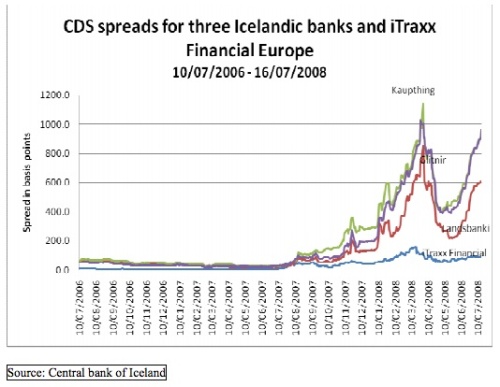4 Reasons Why The Market Wasn’t That Perfect
 Before the 2008 subprime mortgage crisis happened, economic policymakers of developed countries thought they had reached a complete integration of economic theory and practice. The United States—and most of the world’s developed, mature economies, was believed to have reached its ideal state of market efficiency. The panacea for short-term fluctuations in the business cycle of developed countries was believed to have been found: it is a balanced mixture of monetary policy independence, rule-based stabilization policies, financial deregulation, and trade liberalization. Prof. Taylor prided himself in the robustness of his Taylor rule—the espousal of which had reduced macroeconomic volatility—Prof. Bernanke coined the term ‘the great moderation’ in his 2004 speech, Prof. Lucas declared that technical problems regarding recession-prevention have been resolved. ‘Bubbles’ was a misnomer. Valuation and pricing of every asset was believed to be grounded on concrete, measurable, logical economic drivers.
Before the 2008 subprime mortgage crisis happened, economic policymakers of developed countries thought they had reached a complete integration of economic theory and practice. The United States—and most of the world’s developed, mature economies, was believed to have reached its ideal state of market efficiency. The panacea for short-term fluctuations in the business cycle of developed countries was believed to have been found: it is a balanced mixture of monetary policy independence, rule-based stabilization policies, financial deregulation, and trade liberalization. Prof. Taylor prided himself in the robustness of his Taylor rule—the espousal of which had reduced macroeconomic volatility—Prof. Bernanke coined the term ‘the great moderation’ in his 2004 speech, Prof. Lucas declared that technical problems regarding recession-prevention have been resolved. ‘Bubbles’ was a misnomer. Valuation and pricing of every asset was believed to be grounded on concrete, measurable, logical economic drivers.
This belief stemmed from the idea that as an economy matures and financially modernizes, it becomes more efficient. Such was the case of the United States, as most economists and policy makers believed. Here, ‘efficiency’ was referred to as a concept whereby barriers to competition were minimal, economic agents acted on high level of rationality, information asymmetry no longer predominated, and regulation had ensured the deconstruction of unfair monopolies to allow non-coercive exchanges among members of the economy. Efficiency had also defined by how governments of developed countries had sufficiently learned from monetary, fiscal, and trade policy mishaps their counterparts made in the past. These attributes, coupled with the flawed belief that legal financial/non-financial loopholes had been addressed, justified the correctness of a strong form of an efficient market hypothesis. The term ‘bubble’ was an inaccurate designation—most economists and policy makers believed that the market knows how, why, and what it prices given the complete information available. An asset could not in a bubble. Rather, it could experience a strong upward appreciation of value owing to improving fundamentals.
Regulations of financial institutions were perceived as costly and highly unnecessary. Under the assumptions described in the aforementioned paragraph, financial institutions would thus act cautiously in making investment decisions that expose themselves to risk. Through strategic decision-making processes, they would decide on which risk-to-reward ratio to choose. Take the market of leveraged loans for private equity buyouts, for example. A group of banks deciding to syndicate loans in a highly-levered transaction simply mean that they are willing to take more risk for a higher expected return. Another example lies on the repo-to-CDO market. Intensive involvement in issuing low-yield, short-maturity debt—repo—for it to be used for financing investments in assets of high returns, longer maturity—CDOs—simply means that banks are willing to bear the risk of loss for the action they take. In a perfect market, ‘good’ corporate decisions are reciprocated with rewards, and bad ones are rewarded with losses. Policy makers, with this in mind, thus deemed financial regulation as costly. Some also believed that it would further stymie any form of financial innovation or hinder investments in profitable corporate-level projects. Prior to the crisis, they would feel that the repeal of the Glass-Steagall act of 1933 was justified.
The 2008 financial crisis proved that the belief was somewhat incorrect. The free market wasn’t free, nor was it perfect, and either coincidentally or not, some economists sensed that the perfect state of the efficiency of the financial market seems to be too utopian to be true. Prof. Roubini, Prof. Rajan, and Prof. Blinder attempted to investigate the validity of the assumptions of what makes a free market free of defects, within the context of the U.S. and other developed countries. Despite differences in the way their opinions were conveyed, they were unanimous in their belief on that bubbles are inevitable possibility in every market. In the context of the U.S. financial market, they believed that pricing of assets—particularly real estate and securitized debt obligations—were not necessarily backed by strong fundamentals. The appreciation of asset prices arose not because the market is perfect, but because it is imperfect, a case that is highly probable with transactions involving bank lending.
Sidenote: More background from a politician perspective can be found here, an article I wrote 2 years ago.
Why wasn’t it perfect?
Inspired from the explanation of these economists, I argue that these imperfections originated from the tenuousness of at least four (4) assumptions supporting the notion of a perfectly competitive market.
The first assumption relates to the incorrect notion that information asymmetry among economic agents no longer exist in developed capital markets. In a market with no information asymmetry, prices are determined based on the considerations of the seller and the buyer with equal access to information integral to asset pricing. However, prior to the 2008 calamity, banks had possessed more information regarding the actual components of the CDOs they securitized with complex financial engineering. Indeed, investors received investment prospectuses, but the triple-A stamp on the tranches they purchased made the idea of re-valuing the product for crosschecking purposes unnecessary. Furthermore, investors were unaware that banks had the right to purchase CDSs on the CDOs they purchased—another naked form of information asymmetry.
The second assumption is associated with the wrong belief that developed countries would have capital markets free of conflict of interest among economic agents. Prior to the crisis, credit rating agencies and banks performed business through an issuer-pay business model. The model arguable generated conflict of interest, as the incentive to maintain a neutral evaluation of credit quality of debt products securitized by their own clients would dissolve. The agencies were funded by their clients—mostly investment banks with securitization capabilities—to assess the credit quality of all tranches (as well as financially engineered sub-tranches) of collateralized debt obligations (CDOs) their clients intend to sell to willing institutional investors. Given the risky nature of the CDOs stemming from the subprime creditworthiness of the borrowers as well as mortgages being a majority portion constituting them, the banks arguably prefer to dispossess of them as soon as possible from their balance sheet. The agencies were aware of this, yet economists argued that they were incentivized them to improve their ratings of the CDOs they were paid to rate, under the spirit of client satisfaction and retention. According to policy makers, investors and CDS issuers were endangered by this practice as the issuer-pays model leads to the collateralized debt being over-rated—the asset value does not reflect its true risk levels.
The third assumption is connected to the erroneous view that moral hazard within the financial markets was an old cliché, as it has been successfully mitigated with existing financial regulation. In this case, moral hazard stemmed from the fact that agents lost their incentives to perform based on a risk-reward standpoint as they were allowed to shift risks to other parties without bearing any risks themselves. Before Dodd-Frank was introduced, banks need not have their risky, self-securitized risky debt in their balance sheet, before selling them to their clients or potential investors. This created moral hazard as expected profit/reward was no longer from the risk to which they were exposed; it was gained from speed: the faster risky securitized debt obligations can be sold, the more they gained.
The fourth assumption, arguably the most classic of all, derives from the inaccurate idea that economic agents are rational. Rational economic agents would evaluate their potential investments carefully and would invest in products that bring benefits both in the short-term and the long-term. In the years prior to the crisis, a large portion of investors subjected themselves to the trend of the herd, relished themselves in their own irrational exuberance, and sought for industries with short-term gains, such as the real estate market. Potential homeowners did not carefully evaluate the mechanics behind their cheap mortgages, and whether or not they were creditworthy enough to acquire the house they intended to buy. Before the crisis, there were tons amazing ads in televisions that getting a home is of utmost importance, irrespective of the need to understand that the debt they borrow were actually priced in a ‘teaser’ rate.
Perfecting the market
Regulators have taken steps toward eliminating the four issues I outlined previously. Lets dissect these steps one-by-one.
The first assumption—existence of information assymmetry—has been approached even within the international arena. G20 leaders have convened to emphasize on the importance of post-trade transparency in the trading of CDSs. In other words, second/third parties purchasing CDSs to hedge/speculate against a potential default of a particular debtor have been mandated to disclose their positions.
The second assumption—conflict of interest among economic agents—has been thought about, too. The Securities Exchange Commission (SEC) formulated new policies entitled “Amendments to Rules for Nationally Recognized Statistical Rating Organizations (NRSROs)”. The SEC has considered the following laws to enact:
- Agencies/NRSROs are prohibited from rating debt instruments they have assisted with structuring;
- Credit analysts of agencies/NRSROs are forbidden in fee negotiations with their clients (the CDO securitizors);
- Agencies/NRSROs have limits on gifts they can receive from their clients;
- Agencies/NRSROs are required to disclose the methodologies, assumptions, and criteria with which they rate the debt instruments to the SEC and/or third-party investors.
The implementation of these rules would reduce mismatched incentives arising from the issuer-pays model.
The third assumption—moral hazard/risk-shifting—has been addressed by mandating banks to have a higher minimum balance of their securitized products sellable to investors. True, the CDO market is back, but I am optimistic that this new regulation, coupled investors being more cautious in their investments, would slowly remove the issue related to the third assumption. The purpose of securitizing CDOs in the first place—risk diversification, not risk amplification—can thus be reached.
The fourth assumption—irrationality of economic agents. How do we make people more rational? Honestly…lets just ask him.








